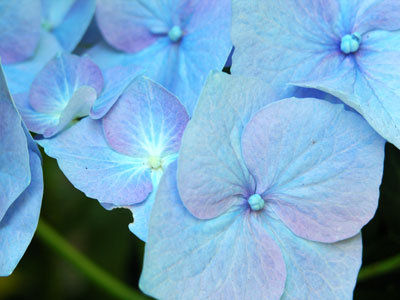
Feeling blue: Help your garden seem bigger than it is
Nature’s favorite color is a washed-out magenta. It’s the original shade of many plants and the one hybrids will revert to if they go to seed. Petunias, garden phlox, sweet peas, nicotiana and foxgloves, for example, will all revert to this shade.
The favorite color of many gardeners, on the other hand, is firehouse red, the winner among tulips, zinnias, dahlias, salvia, impatiens and begonias by a wide margin. Orange and yellow come next, then pink, with blue and white, both comparatively rare in nature, last on the list.
So, naturally, some of us gardeners want the elusive blue flower in our garden. Call us garden snobs. Or maybe we know that cool colors recede. When placed around the edges or at the back of a garden, cool colors make the space appear wider or deeper.
True blue flowers are rare. We use words like cerulean, azure, cobalt, sapphire, turquoise, electric blue and steel blue when describing blue flowers. Hybridizers have tried for years to produce a true blue rose or blue daylily. Because blue plant pigment is hard to manipulate, Donald Wyman, author of Wyman’s Gardening Encyclopedia, explains “Blue, since it occurs in the daylily as a sap-soluble pigment, will be difficult — perhaps impossible — to segregate. Lilacs, purples, orchids, mauves we have; and working with them we may eventually get near blues, but pure blues probably never.”
Recently, some companies have found a way to insert some blue in the center of their daylily flowers, but a totally blue daylily has never been produced.
Rose hybridizers striving for true blue have come close by crossbreeding lavender hybrid teas to produce offspring having optimum amounts of cyanidin, the pigment that imparts purple or magenta tones, and flavone, the pigment that gives light yellow tones. The results have been more of a silvery lilac or mauve. A blue rose is still in the future, although labs in Australia and Japan are genetically modifying the pigments from petunias to produce a blue rose. Their results are not yet perfected, and these roses are more of a lilac in color and can not survive conditions outside the lab.
It is apparently very difficult to isolate the pigment cyanidin. Delphiniums have a monopoly on it and so far aren’t giving up any of their secrets.
The color blue is calming and tranquil. It is the color of serenity and peace and is said to slow down the metabolism and reduce the appetite. When brightened with white or combined with yellow or orange in a complementary-color scheme, the results of blue in the garden are breathtaking. The great English gardener Gertrude Jekyll liked to use plants with golden leaves or clear yellow flowers to spice up blue gardens. Just remember that blues and purples are the first flowers to fade as darkness falls, so be sure to have those whites and yellows to carry your garden into evening.
There are many blue perennials as handsome as they are durable that we can enjoy in our gardens today.
Some of my favorites are old-fashioned hydrangeas and campanulas. Both are valuable in the shade garden, along with omphalodes and brunnera. The blue spikes of a long-blooming peach-leaf campanula just go together with the white-and-green variegated foliage of Jack Frost Siberian bugloss (where do they come up with these names?).
In early spring, we are dazzled by our native ceanothus, which bloom with deep blue, sky blue or electric blue flowers. Emerald Blue creeping phlox (Phlox subulata) carpets the ground in spring with deep blue flowers that top creeping stems. Blue Springs penstemon, a California native hybrid, carries dense spikes of bright blue, bell-shaped blossoms.
I have a long list of other plants to add to your blue garden. E-mail me and I’ll give you lots more ideas.
Jan Nelson, a landscape designer and California certified nursery professional at Plant Works in Ben Lomond, will answer questions about gardening in the Santa Cruz Mountains. E-mail her at ja******@*ol.com, or visit www.jannelsonlandscapedesign.com to view previous columns and pictures.












